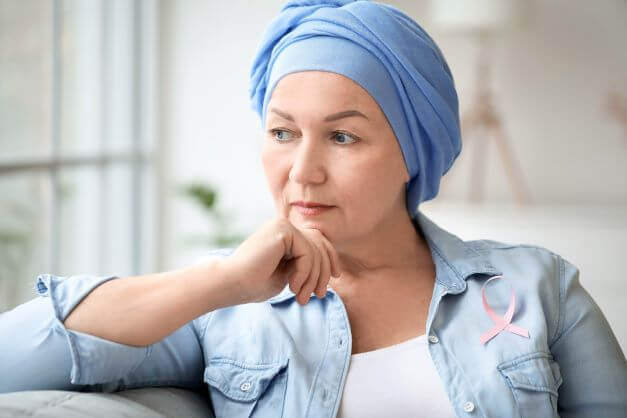A cancer diagnosis usually means you can expect a lot of changes in your life. The impact of a cancer diagnosis on your hair, skin, and nails may be the last thing on your mind, but the potential adverse effects of cancer treatments on your skin should be something you’re aware of and ready to address. According to Dr. Sam Awan of U.S. Dermatology Partners in McKinney, Texas, “Of the many cancer treatment side effects, those that impact the hair, skin, and nails can negatively affect your daily life more profoundly than you might imagine. From cancer treatments causing hair loss and nail brittleness to serious skin dryness, rashes, sores, and other skin health concerns, fighting cancer can cause profound discomfort. A dermatologist can help you prevent skin side effects from cancer treatments whenever possible and take steps to address those that do arise.” If you want to learn more about the ways that cancer treatment impacts your skin, keep reading this blog. Dr. Awan will walk through the common skin side effects from cancer treatments and recommendations for how to handle any skin health symptoms you experience.
What Are the Common Cancer Treatment Skin Side Effects?
There are many different types of cancer treatments, including chemotherapy, immunotherapy, targeted therapy, and radiation. They all target cancerous cells, either directly or through stimulation of the immune system’s natural defenses. Unfortunately, they can also affect healthy parts of the body, including the hair, skin, and nails. Even if the treatment itself doesn’t directly damage the hair, skin, and nails, they can still be impacted by the treatments. Dr. Awan says, “Cancer treatments can affect our skin, hair, and nails in a number of different ways. Almost all cancer treatments can lead to dry skin and generalized itching. Many classic chemotherapies can lead to hair loss and nail changes. The newer immunotherapies can lead to the development of rashes such as psoriasis, eczema, and even autoimmune blistering disease. Each cancer treatment affects the body differently, so it’s important to create an individualized treatment plan with a dermatologist early on. Not all skin changes are necessarily bad – some studies have shown that certain rashes are a sign that the cancer treatment is working, and are a positive sign that the treatment is making a difference. Our goal as dermatologists is to support your oncologist and allow you to stay on your cancer treatment whenever possible.”
The following are some of the most common cancer treatment skin side effects:
- Dry skin – Very dry, itchy, burning, or stinging skin is common. This can be localized or widespread.
- Itching – this usually goes hand in hand with dry skin, but many patients develop moderate to severe itching that can have a negative impact on their quality of life.
- Changes in skin tone – Chemotherapy and immunotherapy can both cause changes in the skin’s natural tone, leading to lighter or darker coloring. You may also notice hair and nails looking lighter or darker than their natural coloring. Some patients will develop a condition called vitiligo, which is when overactivation of the immune system leads to loss of pigment in certain parts of the skin.
- Rashes and sores – Some forms of cancer treatment may lead to skin rashes and sores. Because of the risk of infection, it’s important to monitor these wounds and follow your doctor’s instructions for treatment.
- Sunburns – Some cancer treatments can increase skin’s sensitivity to the sun, leading to a greater risk for sunburns as well as skin darkening when exposed to sunlight.
- New skin growths – Moles, warts, and lesions may develop. In most cases, these are benign, but it’s important to check any new lesions that develop during cancer treatments to ensure they are not signs of developing skin cancer.
- Hair loss – Many people are aware of hair loss related to chemotherapy. Other cancer treatments can also cause hair loss and thinning as nutrients and cell regeneration energy is used in other areas as the treatments weaken the body.
- Nail brittleness – The nails may get darker and become weak and break or split. The cuticles may also hurt.
Can I Prevent Skin Side Effects from Cancer Treatment?
When it comes to skin side effects from cancer treatment, Dr. Awan says, “Even with the best skincare routine, most dedication to preventive measures, and healthiest lifestyle, you probably won’t be able to avoid all the changes skin cancer causes to your skin. Even so, it’s still very important to maintain a good skincare routine each day and address any changes in your skin as soon as they appear.” While everyone can experience skin changes due to cancer treatments, those who already have pre-existing skin conditions like eczema, rosacea, and psoriasis may be at an increased risk for more severe symptoms, so it’s especially important to manage these skin conditions well in partnership with a dermatologist to keep skin healthy throughout cancer treatments. Here are some of Dr. Awan’s top recommendations for keeping skin healthy at every stage of skin cancer treatment:
- Maintain a good daily skincare routine. Use mild, gentle skincare products or those that are specifically recommended by your dermatologist and/or oncologist. Review your current skincare products with your oncologist or dermatologist. Some powders, foundations, and antiperspirants can cause unnecessary irritation to the skin during treatments, and your dermatologist can help you avoid these products. You should also do your utmost to avoid skincare products that contain alcohol, fragrances, dyes, and other drying and irritating ingredients.
- You may need to adjust your bathing and showering routine. It might sound counterintuitive, but showering and bathing can actually strip moisture from the skin. We recommend taking short showers in lukewarm water rather than hot. If you want to take a bath, use ultra-nourishing colloidal oatmeal to soothe and hydrate your skin while bathing, and don’t make the water too warm. After you shower or bathe, gently pat your skin dry, and immediately apply moisturizer.
- Keep skin hydrated. Moisturizing is essential throughout the cancer treatment process. Use a gentle, cream-based moisturizer to keep skin hydrated and avoid cracking and breaks that can increase the risk of infection. Dr. Awan often recommends over-the-counter moisturizers such as Eucerin Advanced or Eucerin Eczema Relief, CeraVe, or LaRoche-Posay. Applying a moisturizer after a shower and again before bed is the best way to ensure skin hydration.
- Over-the-counter itch relief creams include Sarna and CeraVe Itch Relief. If the itch is persistent, a dermatologist has prescription creams and may even offer in-office phototherapy treatments to help relieve itch.
- Apply sunscreen every day to all parts of the body that will receive sun exposure. Some forms of chemotherapy and immunotherapy increase sun sensitivity. Applying sunscreen may be especially important for individuals who are receiving these treatments, but everyone should apply a broad-spectrum sunscreen of SPF 30 or higher every day.
- Some cancer treatments can cause pressure rashes on the feet. Tight or ill-fitting shoes contribute to this condition, so it’s essential to wear comfortable shoes. If you are on a cancer treatment that can affect the hands and feet, take care to decrease friction to these areas. Wear gloves when washing dishes, avoid strenuous exercise or pressure to the feet, and use a urea-based moisturizer regularly.
- Prevent and treat minor injuries or infections. You may notice peeling skin, pain, or dampness in areas where skin folds such as around the ears, breasts, underarms, knees, elbows, and bottom. Keep these areas clean and dry and use medicated creams and other treatments as necessary to prevent infection.
- Care for your nails by keeping them clean and cut short. This prevents ripping or pulling at the nails. For this reason, you may also want to wear gloves while performing household chores. If you notice nail injuries or other problems, consult with a doctor about appropriate treatment.
When Should a Dermatologist Address Skin Side Effects from Cancer Treatment?
According to Dr. Awan, “If you take preventive steps to keep skin healthy and maintain a good skincare routine, you may not need much treatment for skin side effects. In many cases, you may just need to use over-the-counter medicated creams like the ones mentioned above. However, with some cancer treatments, an early visit to the dermatologist can be beneficial. For my patients on EGFR inhibitor cancer therapies, I start a preventive routine even prior to their first dose that will help decrease the chances of developing a rash. When in doubt, talk to your oncologist about the type of treatment you will be receiving, and ask if an early referral to a dermatologist would be helpful.”
When Should I Schedule a Dermatology Appointment?
As soon as you know you are going to be experiencing chemotherapy or radiation therapy, you should schedule an appointment with your dermatologist. They can examine your skin for any areas of concern. Then, the dermatologist will walk you through any steps you should take before, during, and after treatment to prevent skin side effects. A dermatologist also helps you develop a good skincare routine to use throughout your treatment to ensure you experience minimal skin health effects. If you’re ready to get started working with a U.S. Dermatology Partners location near you, take a few minutes to complete our online scheduling request. Once we hear from you, we’ll be back in touch to finalize the details of your visit.
Find a location near me
or


